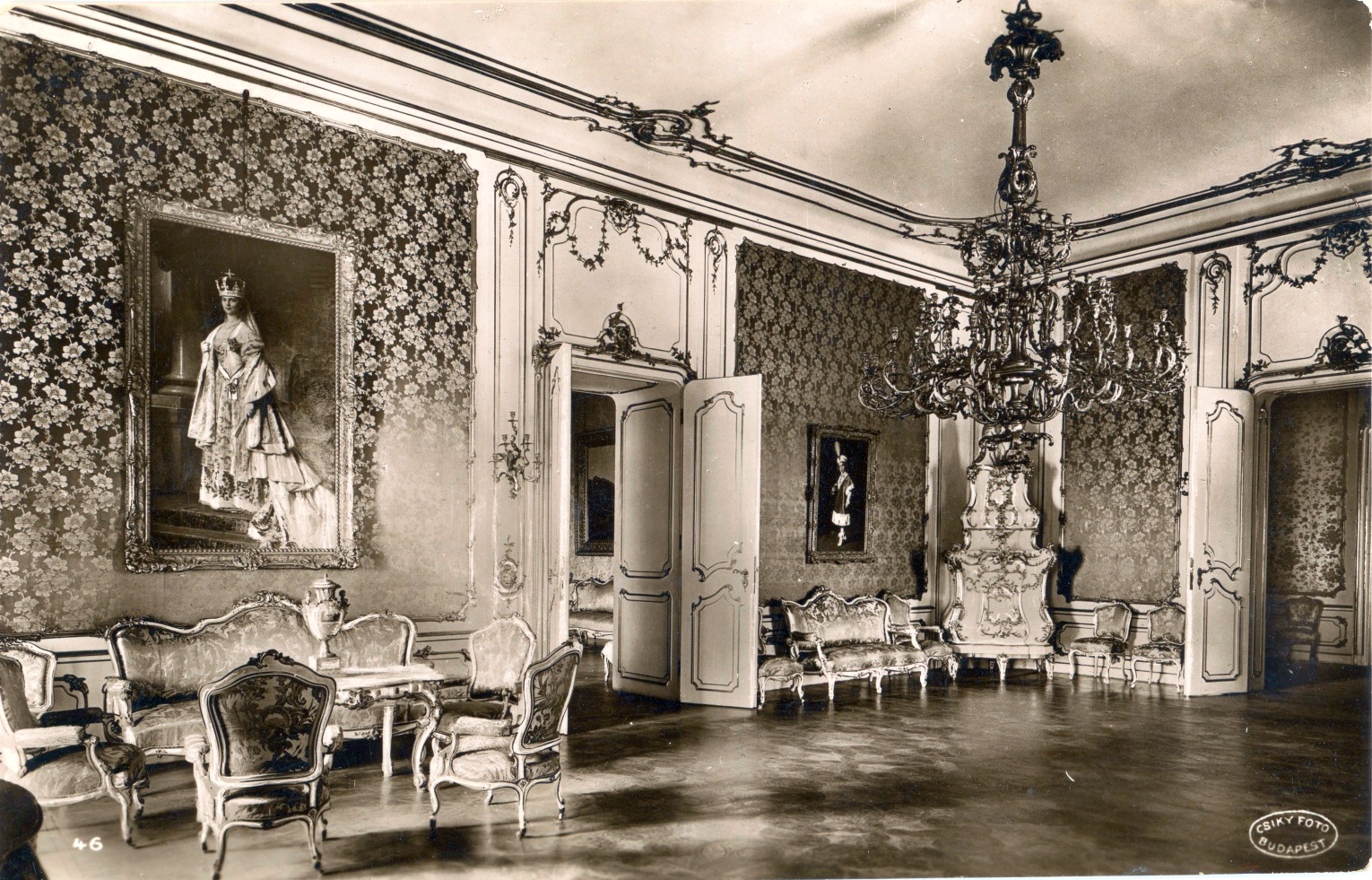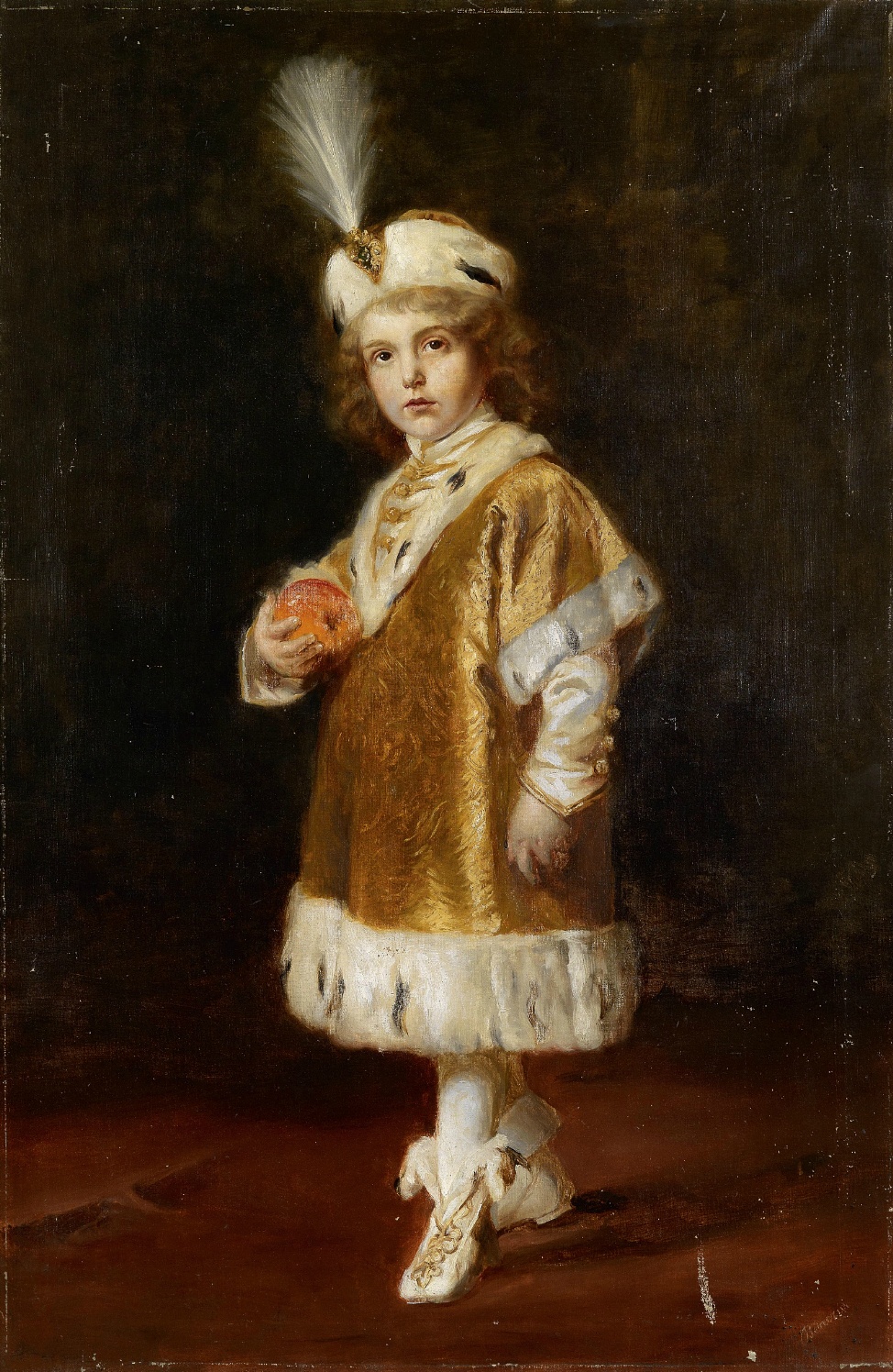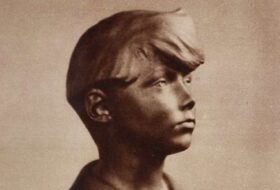This time we were particularly lucky: on the website of the Kieselbach Gallery, we discovered a painting showing a part of a salon of the Royal Castle of Buda, on the wall of which hangs a full-figure portrait of the child Otto by Gyula Benczúr, depicting the heir to the throne in his coronation gown designed by Benczúr (today: Hungarian National Museum, Historical Picture Gallery). In response to our enquiries, the owner of the gallery not only donated the painting to the Foundation’s collection but also had it restored.
A photograph (Csiky photo) from the 1930s has survived, which – among other things – can be found in the collection of our Foundation,[1] based on which it is not difficult to recognise that the painting depicts the Rose Salon (or as it is also called: the South Hall of Mirrors) of the Royal Palace in Buda, recomposed without the claim of being topographically accurate. Instead of the rose-patterned wallpaper, the walls are plain blue, the upholstery of the furniture, originally in brocade, is undecorated, and the painting of Benczúr, depicted in broad lines, was moved from the right side of the door to the left, where, according to the photographic record, the coronation portrait of Queen Zita once hung.
The painting is signed (bottom right), but its creator is not one of the artists who are still considered worthy of recognition, although she regularly exhibited her works at the National Salon. The portrait of Mariska Klammer is yet unknown, and the few biographical data available do not provide detailed information about her. Her date of birth is also uncertain: besides 1873, 1877 is often mentioned. If we take into consideration that on the website of the Hungarian Royal Drawing School and Art Teachers’ College – now the Hungarian University of Fine Arts – she is listed among the students attending the institution from 1891 to 1906, then the first date is more likely.
According to The Lexicon of Hungarian Resurrection[2] published in 1930 – presumably based on information from the artist herself – she was not only a student of Lajos Deák Ébner in Budapest, but also studied in Munich and Paris, and her teachers included Anton Azbe, Hans von Hayek, Lucien Simon and Emil Blanche; she also made her debut in several European cities. Her activities in the Association of Hungarian Women Artists (from 1908), of which she was one of the Vice-Presidents when founded, were considered a great merit, but she also promoted the recognition of women in other fields. She regularly participated in the annual exhibitions of the National Salon, and the Museum of Fine Arts bought two of her paintings in 1909. She herself operated a painting school, organised workshop exhibitions with her students and also donated some of her artworks to charity. She was mostly known as an interior and still-life painter, her figurative works were often less successful. The critics of her debuts generally praised her art, but she received little more than a single sentence in the reviews of the collective exhibitions.
The catalogue of the exhibition at the National Salon in May 1924 includes eight paintings by Mariska Klammer. Among them are painting No. 120, entitled Blue Salon in the Royal Palace, oil on canvas,[3] and painting No. 122, titled Interior in the Royal Palace. The first may be the same as our picture (size data are missing), which may give us the date of the work: the portrait of Benczúr was painted in 1917.
It appears not only from the above catalogue that the artist made several paintings of the interior of the palace in different colours, some of them simplified or combining elements of the palace’s furnishings, and mostly identical in size to the painting in our collection from the Kieselbach Gallery. The details of the compositions (of which we have seen 5 so far) – chandeliers, stoves, pieces of furniture, wall decorations – give evidence of this, but their exact date of creation is yet to be identified.[4]
Mariska Klammer appeared in exhibitions year after year, so her name was well known and often appeared in the press. So much so that when the news of her mother’s death was published (18 January 1937), the Hungarian Telegraphic Office noted: “Painter Mariska Klammer mourns her mother in her passing”. In the years of the Second World War, when Hungary was increasingly suffering, her name does not appear: in June 1943, she was still included in the June exhibition of the National Salon, and the next time she is mentioned is in 1947 when her painting Peonies was the only one displayed in the August exhibition of the National Salon – possibly it was her last appearance.
We are grateful to Tamás Kieselbach for donating the painting to our Foundation, thus recalling the noble gesture of patronage that was much more common in Mariska Klammer’s time!
Eszter Fábry
[1] Tag: HOAL II-3-c F2
[2] Magyar feltámadás lexikona. Ed. by Géza Szentmiklósy, Budapest, 1930.
[3] On page 12 of the unnumbered pages of the catalogue, including the title page.
[4] For example, the stove in the so-called Small Salon of Buda Castle (see FSZEK Budapest Collection) appears in two paintings by Mariska Klammer, and the salon suite is very similar to the ensemble of armchairs in the Rose Salon. Cf. Mariska Klammer: Interior and Mariska Klammer: Castle Interior.



